Armadillos and anteaters are some of the first animals we learn about when learning the alphabet, but did you know they are also some of the most interesting animals around? These two animals are actually quite similar in a lot of ways, although they do have their distinct differences. Today, we are going to compare the two and learn what truly makes them unique. Let’s discover the armadillo vs the anteater and what makes them different.
Comparing an Armadillo and an Anteater
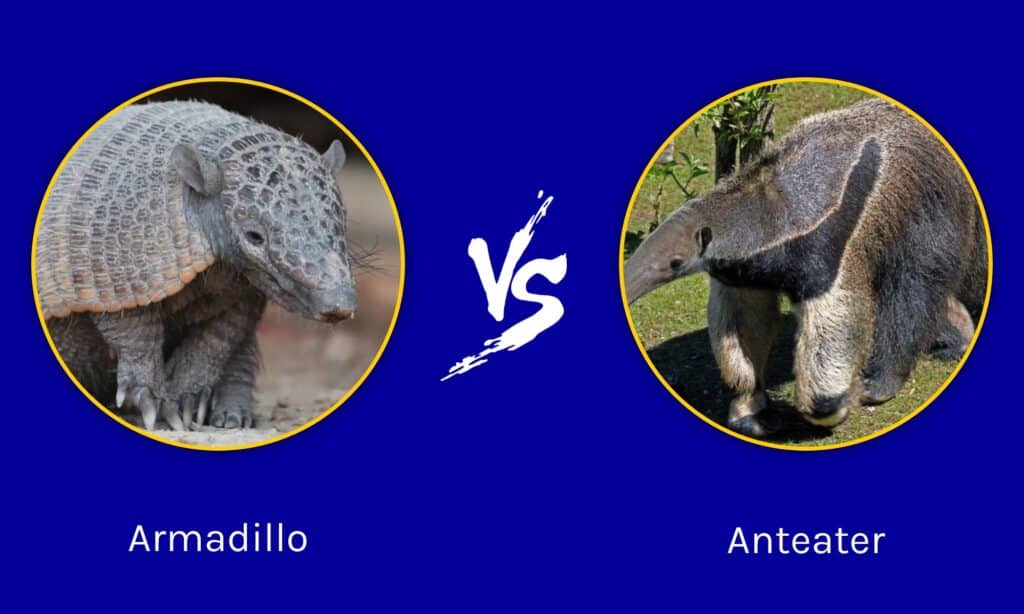
| Armadillo | Anteater | |
|---|---|---|
| Size | Varies with species. Generally 30 inches (including the tail) and 3-10 pounds. | Varies with species. Ranges between 2-6 feet long and 10-100 pounds. |
| Armor | Bone covered in keratinized skin. Certain species have bonier plating. | No armor. |
| Hair | Short, fuzzy hair on body and face. | Medium to long hair that covers the entire body. |
| Diet | Ants and termites. | Invertebrates, grubs, insects. |
| Feeding adaptations | Digging claws | Highly specialized tongue, tubelike snout, digging claws, folded stomach lining. |
| Species | 21 distinct species across 9 genera | 4 extant species. |
The Key Differences Between an Armadillo and an Anteater
The key differences between an armadillo and an anteater are size, armor, hair, diet, feeding, and number of species.
Although you wouldn’t know it from their looks, armadillos and anteaters are closely related! The two animals are native to Central and South America and have evolved as somewhat similar cousins. For a long time, people believed them to be closer related to pangolins and aardvarks, but recent data has shown them to be more closely related to one another than anything else!
Across both animals is a wide array of species, all with their unique traits. The armadillo, for example, is usually the size of a small possum, but the largest species can weigh as much as 120 lbs! Similarly, the smallest anteater, the silky anteater, is smaller than a housecat, while the giant anteater can weigh as much as 160 lbs. Still, despite the variance across the species, there are some similarities that unite them and differentiate them from other animals.
Let’s dive into what differentiates the armadillo from the anteater!
Armadillo vs Anteater: Size
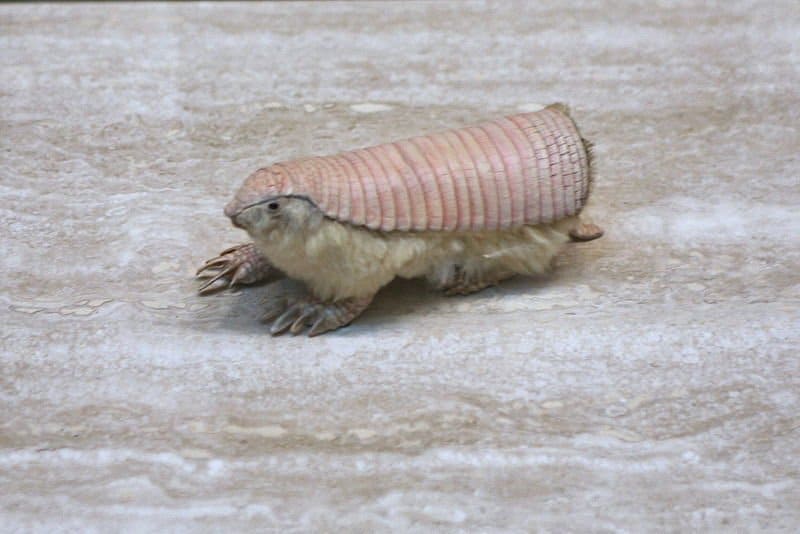
The pink fairy armadillo is the smallest of all armadillo species.
©Cliff / CC BY 2.0 – License
On average, the armadillo is smaller in size than the anteater. The smallest species of armadillo is the pink fairy armadillo, which only grows to 6 inches long and weighs a quarter pound. These tiny animals live in the deep deserts of central Argentina and are becoming increasingly threatened. The largest species of armadillo, the giant armadillo, can measure up to 60 inches and weigh a whopping 120 lbs in the wild.
The anteater also has a variety of sizes within its four species. The smallest of the anteaters is the silky anteater, which can grow to 18 inches long and weigh up to a pound. The giant anteater is the largest anteater in the world (as the name would suggest) and measures up to 6 feet long, and can weigh 160 lbs in the wild.
Armadillo vs Anteater: Armor
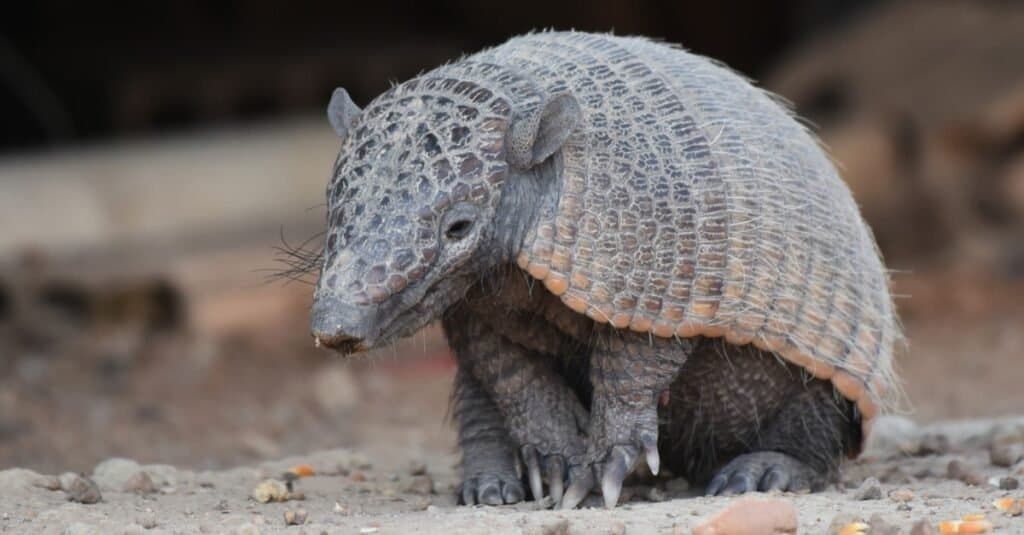
Armadillos are covered in bony plates that create their ‘armor.’
©iStock.com/Rini Kools
One of the unique features of an armadillo is its armor. Most species of armadillo have a leathery shell that covers their back and head in order to protect themselves from predators. Their armor is made of a layer of bone covered in keratin scales. The shell is usually most rigid across its shoulders and often has rigid bands separated by skin. This banding allows them to ball up when necessary.
Anteaters have no such defense when it comes to their skin. Instead of armor, an anteater protects itself by rearing onto its hind legs and leaning back in its tails. With its legs free, it displays its digging claws. The pose is quite comical to many people, although they are known to defend themselves from jaguars successfully.
Armadillo vs Anteater: Hair
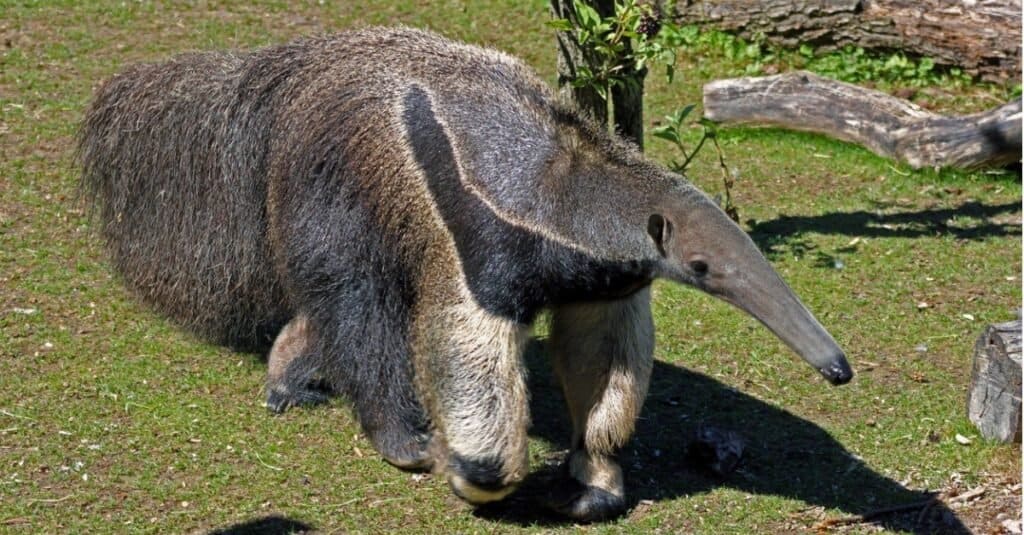
Anteaters are covered in dense body hair.
©iStock.com/Ivan Mattioli
The armadillo is known for its armor, although it does have hair across its body. The highest density of hair is under its belly, as there is no armor protection. Generally, an armadillo’s hair is fluffy and white. Armadillos also have hair on their heads and legs, but this hair is a bit more rigid and sparse than on other places on their bodies.
Anteaters don’t have armor across their bodies as armadillos do, but they do have hair! The entire body of an anteater is usually covered in black, white, or brown hair. It’s usually quite coarse and can grow long around the tail. The silky anteater has uniquely dense and soft hair covering its entire body. The softness of the hair gives the silky anteater its name.
Armadillo vs Anteater: Diet

Anteaters mostly feed on ants and termites.
©user:Borsi112, CC BY-SA 3.0, via Wikimedia Commons – License
Armadillos are generalists when it comes to food, but there are a few species with preferred prey sources. Most armadillos eat invertebrates and insects. Their favorite foods include grubs, worms, scorpions, ants, and termites. A few species of armadillo are adept at digging into termite mounds and can eat entire colonies in one sitting.
Anteaters are well known for their favorite food, as can be seen in their name! Giant anteaters exclusively eat ants and termites, with the other species eating a slightly higher number of insect species. A giant anteater can visit as many as 200 nests a day in order to get enough food to sustain itself. The other species are more arboreal in nature (living in trees) and eat the insects they can find in the treetops.
Armadillo vs Anteater: Feeding adaptations
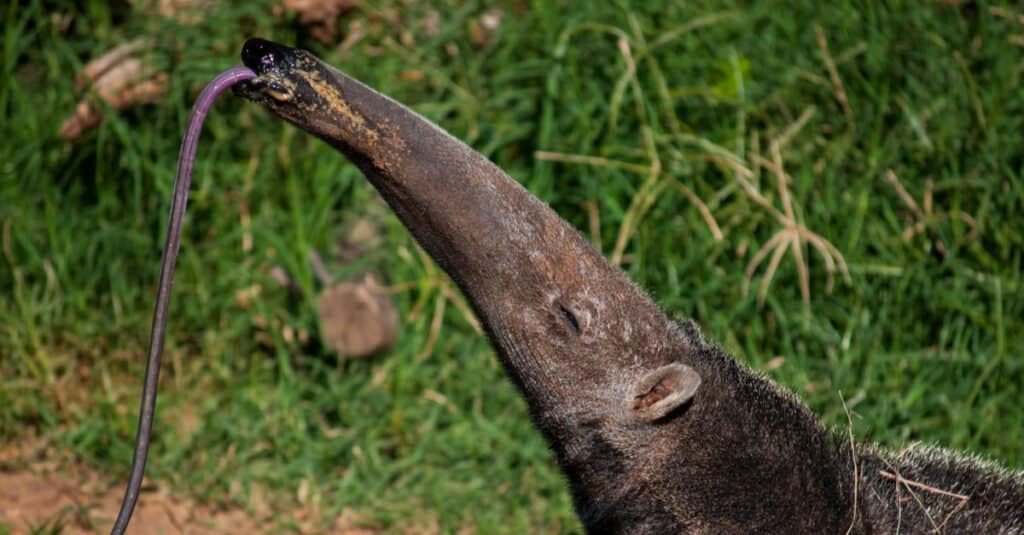
Anteaters have highly adapted tongues, snouts, and stomachs in order to gather and process enough ants and termites.
©esdeem/Shutterstock.com
Armadillos are borrowers and often dig in the ground for their food. As such, they usually have a great sense of smell and large digging claws that can clear dirt. When they sniff some prey out, they are able to rapidly dig it out using their strong claws.
Anteaters have a few adaptations that make them quite unique. First is their tongue, an organ covered in small hooks and constantly coated in saliva. An anteater can flick their tongue over 150 times a minute down a tubelike snout that coats the tongue in sticky saliva. Additionally, the stomach folds of an anteater are hardened and crush insects up (with the help of sand) as they eat.
Armadillo vs Anteater: Species
There are currently 21 species of armadillo spread across Central and South America.
There are currently 4 species of anteater spread across Central and South America.
The photo featured at the top of this post is © Heiko Kiera/Shutterstock.com
Thank you for reading! Have some feedback for us? Contact the AZ Animals editorial team.






